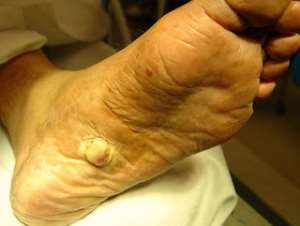
In July 1981, there appeared Centers for Disease Control report in the MMWR entitled "Kaposi's Sarcoma and Pneumocystis Pneumonia Among Homosexual Men - New York City and California." This introduced 26 cases of Kaposi's sarcoma (KS), the second important symptomatic pneumonia disease of Aids.
Of the 26 patients, 20 came from New York. The first actual scientific contribution on Kaposi's sarcoma among homosexual men was published on September 19, 1981, in the Lancet. It deals with the case history of eight men.
The authors were trying to justify why Kaposi's sarcoma which, no doubt was rare but not unknown, was specifically treated as a new disease for these particular patients.
The first argument put forward was that opposed to previous cases, younger men are now affected. That is quite incorrect: In his description of the clinical picture of six persons, leading to the classification of the disease for the first time in 1872 and hence, its introduction medical science, the Austrian physician Moriz Kaposi actually made reference to a 45-year-old and an eight-year-old patient.
The eight New York patients were between 27 and 45 years of age. Furthermore, the lancet authors believe that the skin symptoms no longer predominantly affect the lower limbs but rather the body as a whole. However, this would not correctly reproduce the observations made by Kaposi.
These minor changes in the Lancet article compared with Kaposi's observations do not justify the reporting of an allegedly new disease in a scientific journal. Also, the observation that "the disease" (even at that time designated as such in the singular, in only eight persons) was adopting a more aggressive course, is wrong.
Instead of eight to thirteen years, the patient's duration of survival is generally a period less than twenty months. Hence, even this is not new: Of Kaposi's six patients, one went home after two months to die, one died after six weeks and one after one year.
Kaposi estimated: "The disease ultimately leads to death, within a short period of two to three years." Of the eight Lancet patients, four died after 30 months, four survived of whom two were cured at the time of the publication. One of the two, a 34-year-old Italian, was included in the study in 1990, as an example of a mild form of Kaposi's sarcoma without HIV-infection and without any impairment to a relationship between helper cells and suppressor cells.
Neither the number nor the affected parts of the body or the aggressiveness of the diseases would give an impartial physician cause to talk about a new disease. Let us stick with homosexuality of the 'young men.' Since Kaposi's sarcoma occurs in men in 95% cases and since the eight diseases were diagnosed by eight physicians in three special clinics.
It is quite striking that the patients' sexual orientation was worth mentioning. Noticeable also is the manner in which the 'black' patient was described: "The only black patient in our study was born in America and had never been to Africa."
He is characterized by the term "the only" which suggests an under-representation, although one of the eight US citizens, 12% has dark skin-colouring. The country of birth was only given to the patient with the dark skin colour, and not for the other seven.
And exclusively with respect to this patient, it is mentioned that he had never been to Africa.




 Chief arrested for killing soldier at Kasoa over land
Chief arrested for killing soldier at Kasoa over land
 GAF probes soldier’s murder at Kasoa Millenium City
GAF probes soldier’s murder at Kasoa Millenium City
 Ghana steps up effort to pass new Labour law
Ghana steps up effort to pass new Labour law
 AG advises EOCO against money laundering probe into Cecilia Abena Dapaah’s affai...
AG advises EOCO against money laundering probe into Cecilia Abena Dapaah’s affai...
 May Day: I'll prioritise welfare of workers, abolish compulsory retirement age a...
May Day: I'll prioritise welfare of workers, abolish compulsory retirement age a...
 V/R: Adaklu-Tevikpo murder suspect arrested from hideout
V/R: Adaklu-Tevikpo murder suspect arrested from hideout
 Kasoa: Soldier killed by alleged land guards over land dispute — GAF
Kasoa: Soldier killed by alleged land guards over land dispute — GAF
 Fatal shooting of soldier happened at Gomoa East not Kasoa; stop tarnishing our ...
Fatal shooting of soldier happened at Gomoa East not Kasoa; stop tarnishing our ...
 ‘We condemn unprovoked attack in no uncertain terms’ — GAF on fatal shooting of ...
‘We condemn unprovoked attack in no uncertain terms’ — GAF on fatal shooting of ...
 Ghanaians urged to ensure violence free elections on December 7
Ghanaians urged to ensure violence free elections on December 7
